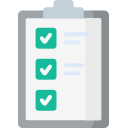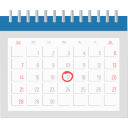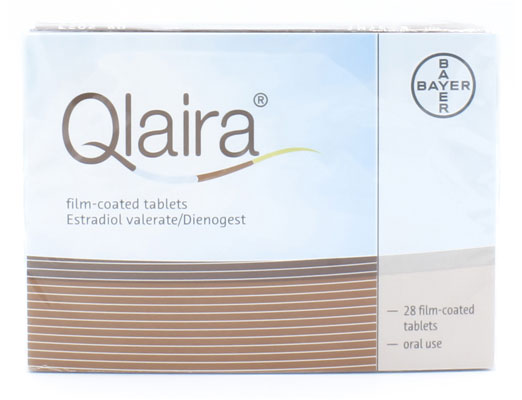Qlaira

Qlaira is an oral contraceptive pill used to prevent pregnancy. It is also used for the treatment of heavy menstrual bleeding (not caused by any disease of the womb) in women who wish to use oral contraception.

Qlaira contains a small amount of the female hormones estradiol valerate and dienogest. Estradiol valerate and dienogest are synthetic versions of the naturally occurring female sex hormones, oestrogen and progesterone Qlaira tablet works just like many of the traditional birth control pills in that it prevents ovulation. The product is as effective as the traditional prescriptions. Testing in the United Kingdom has yielded an impressive 80 percent satisfaction rating.

Effective control of spotting and bleeding, Consistent cycles, Effective contraception, Few or no side effects.
How does Qlaira work?
Qlaira tricks your body into thinking that ovulation has already taken place; in doing so there is a very strong chance an egg will not be released during your menstrual cycle. Qlaira alters the consistency of the womb lining so that an egg can not implant itself there to grow, and thickens the cervical fluid making it tough for a sperm to entering the womb for fertilisation to take place.
Read the Patient Information Leaflet
How much does Qlaira cost?

Packs and prices

We offer fast, next-day shipping on orders placed before 3pm, so you have your medication when you need it.

You will have continued support from our doctor or our care team here at PrivateDoc.
Possible side effects
As with many types of medication obtained with a prescription, women who take this contraceptive pill for the time may experience bouts of mild side effects. However, it should be made clear that these effects usually subside as your body gets used to the ingredients in the Cerazette pill. The most commonly reported side effects of this contraceptive include: headache, nausea, acne, breast pain, weight gain, changes in mood, decreased libido and irregular periods.
Get StartedPossible side effects
Like all medicines, Qlaira can cause side effects, although not everybody gets them.
Serious side effects
Serious reactions associated with the use of the pill, as well as the related symptoms, are described in the Patient Information Leaflet in the following sections: “Qlaira and venous/arterial blood clots” and “Qlaira and cancer”. Please read these sections carefully and consult your doctor at once where appropriate.
The following side effects have been linked with the use of Qlaira:
Common side effects (between 1 and 10 in every 100 users may be affected):
- headache
- abdominal pain, nausea
- acne
- no periods, breast discomfort, painful periods, irregular bleeding (heavy irregular bleeding)
- weight gain
Uncommon side effects (between 1 and 10 in every 1,000 users may be affected):
- fungal infections, fungal infection of the vulva and vagina, vaginal infection
- increased appetite
- depression, depressed mood, emotional disorder, problems sleeping, decreased interest in sex, mental disorder, mood swings
- dizziness, migraine
- hot flush, high blood pressure,
- diarrhoea, vomiting
- increased liver enzymes
- hair loss, excessive sweating (hyperhidrosis), itching, rash
- muscle cramps
- swollen breasts, lumps in the breast, abnormal cell growth on the neck of the womb (cervical dysplasia), dysfunctional genital bleeding, pain with intercourse, fibrocystic breast disease, heavy periods, menstrual disorders, ovarian cyst, pelvic pain, premenstrual syndrome, growth in the uterus, contractions of the uterus, uterine/vaginal bleeding incl. spotting, vaginal discharge, vulvovaginal dryness
- fatigue, irritability, swelling of parts of your body, e.g. ankles (oedema)
- weight loss, blood pressure changes.
Rare side effects (between 1 and 10 in every 10,000 users may be affected):
- candida infection, oral herpes, pelvic inflammatory disease, a vessel disease of the eye resembling a fungal infection (presumed ocular histoplasmosis syndrome), a fungal infection of the skin (tinea versicolor), urinary tract infection, bacterial inflammation of the vagina,
- fluid retention, increase in certain blood fats (triglycerides), aggression, anxiety, feelings of unhappiness, increased interest in sex, nervousness, night mare, restlessness, problems sleeping, stress
- reduced attention, “pins and needles”, giddiness
- contact lens intolerance, dry eye, eye swelling
- heart attack (myocardial infarction), palpitations
- bleeding in a varicose vein, low blood pressure, inflammation of superficial veins, painful veins
- constipation, dry mouth, indigestion, heartburn
- liver nodules (focal nodular hyperplasia) , chronic inflammation of gallbladder
- allergic skin reactions, golden brown pigment patches (chloasma) and other pigmentation disorders, male pattern hair growth, excessive hair growth, skin conditions such as dermatitis and neurodermatitis, dandruff and oily skin (seborrhoea) and other skin disorders
- back pain, pain in jaw, sensation of heaviness
- urinary tract pain
- abnormal withdrawal bleeding, benign breast nodules, breast cancer in early stage, breast cysts, breast discharge, polyp on the neck of the womb, reddening on the neck of the womb, bleeding during intercourse, spontaneous milk flow, genital discharge, lighter periods, delayed periods, rupture of an ovarian cyst, vaginal odour, burning sensation in the vulva and vagina, vulvovaginal discomfort
- swollen lymph nodes
- asthma, difficulty in breathing, nose bleeding
- chest pain , tiredness and feeling generally unwell, fever
- abnormal smear from the neck of the womb
Read the Patient Information Leaflet
How to take Qlaira
Each wallet contains 26 coloured active tablets and 2 white inactive tablets.
Take one tablet of Qlaira every day, if necessary with a small amount of water. You may take the tablets with or without food, but you should take the tablets at around the same time every day.
Read the Patient Information Leaflet
Get Started How much does Qlaira cost?





